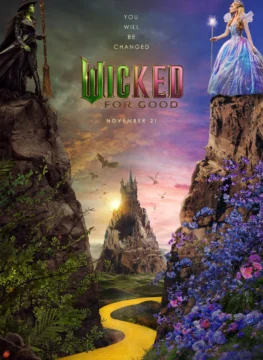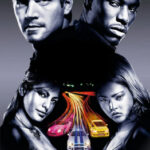
Wicked: For Good Post-Credit Scene Explained
137 minutes
November 4, 2025
Wicked: For Good Post-Credit Scene Explained >> The moment the music swells and Elphaba takes flight, Wicked: For Good delivers one of the most iconic act-one finales in Broadway history. But as the credits begin to roll on Jon M. Chu’s cinematic masterpiece, the big question on every moviegoer’s mind is: “Is it over?”
In an era dominated by cinematic universes, audiences are trained to stay in their seats, waiting for that extra tease. Does this movie-musical follow the trend?
The short answer is: Yes, Wicked: For Good has one crucial mid-credit scene and a small audio-only stinger at the very end of the credits.
For anyone wondering whether to make a dash for the exit or stay put, we’re here to break it all down. This article will cover what the scenes are, what they mean for the announced Wicked: Part Two, and why you absolutely should not leave your seat.
Spoiler warning: This article contains major spoilers for Wicked: For Good and its mid-credit scene.
The Wicked: For Good Post-Credit Scene (Non-Spoiler Guide)
If you want to remain completely unspoiled but just want to know the logistics, here is what to expect:
- Mid-Credit Scene: After the main, stylized credits finish (approximately 2-3 minutes into the credits), the film cuts to a single, story-focused scene that lasts about one minute.
- End-of-Credit Stinger: After the full black-and-white text scroll (about 7-8 minutes later), there is a final, very short audio cue for die-hard fans.
Our verdict is simple: The mid-credit scene is essential viewing and directly sets up the conflict for the sequel. The audio stinger is a fun Easter egg. We highly recommend staying for the first scene.
[MAJOR SPOILERS AHEAD]\
The Wicked: For Good Mid-Credit Scene Explained
The Setting: The Wizard’s grand chamber in the Emerald City. The large, mechanical head is silent in the background.
What Happens: The scene opens not on the Wizard, but on Madame Morrible (played by Michelle Yeoh). She is pacing frantically, enraged by the events at the Kiamo-Ko castle. The Wizard (Jeff Goldblum) is present, but he appears uncharacteristically calm, almost thoughtful.
Morrible is in a panic, stating that Elphaba’s “defiance” (referencing her escape at the end of the film) has made her a martyr. “She’s a symbol, Oz,” Morrible fumes. “And we created her. You created her!”
The Wizard steps out of the shadows, looking at a large map of Oz. He muses, “A symbol can be… repurposed. The people of Oz don’t need a hero, my dear. They need an enemy. Something to unite them. Something to fear.”
He taps the map, specifically on the Eastern land of the Munchkins. “They needed a Wicked Witch,” he says. Morrible looks at him, finally understanding his chilling logic. He isn’t just reacting to Elphaba; he is using her. He is actively creating the propaganda that will brand her as the “Wicked Witch of the West.”
The scene ends with the Wizard turning to a dark corner of the room, where a figure is shrouded. “Prepare my associates in Kansas,” the Wizard commands. “It’s time to… invite a new guest to Oz. Someone to finish what was started.”
The Final Audio Stinger Explained
If you wait through the entire credit roll, the theater goes black and silent. Then, two sounds are heard:
- The unmistakable sound of a cyclone building.
- The distant, faint barking of a small dog.
That’s it. It’s a clear and direct audio tease that Dorothy Gale and Toto are officially on their way.
What This Wicked: For Good Post-Credit Scene Means for Part Two
This mid-credit scene is arguably the most important bridge between Part One and Part Two. While the musical’s act break is a moment of triumph for Elphaba, the movie’s post-credit scene re-centers the plot on the villains.
Here’s a breakdown of its implications:
1. It Confirms the Wizard as the “Big Bad”
Throughout Wicked: For Good, the Wizard is portrayed as a charming, bumbling fraud. We learn he is a “humbug,” but the true extent of his malice is kept ambiguous. This scene strips away that facade. He is no longer a man who accidentally fell into power; he is a calculated, cold, and manipulative propagandist. He understands that to control Oz, he needs to give the people a common enemy, and Elphaba is his perfect scapegoat. This sets him up as the true antagonist for Part Two.
2. It Actively Teases Dorothy’s Arrival
The musical Wicked has a clever structure where the events of The Wizard of Oz happen during the story, often in the background. The film seems to be taking a more direct approach. The mid-credit scene and the audio stinger confirm that the plot to bring Dorothy to Oz is an intentional act orchestrated by the Wizard himself.
As reported by major outlets like Variety, Wicked: Part Two will cover the second act of the musical, which famously runs parallel to Dorothy’s journey. The Wizard’s line, “invite a new guest,” suggests he is actively trying to lure someone (or something) to Oz that can destroy Elphaba for him—a girl in a gingham dress with a house.
3. It Solidifies Morrible’s Role
In the film, Madame Morrible is the one who first brands Elphaba “wicked.” This post-credit scene shows her as the co-conspirator. She is the public-facing voice of the regime (the “Press Secretary,” as director Jon M. Chu has called her in interviews with Collider), while the Wizard is the master strategist. Their partnership is now a central threat.
Why a Post-Credit Scene in a Musical is a Big Deal
The inclusion of a Wicked: For Good post-credit scene is a significant creative choice. For decades, movie-musicals have largely avoided the post-credit trend. Typically, a musical might end with a cast “curtain call” number (like Hairspray or Mamma Mia! Here We Go Again), but rarely does it include a plot-heavy scene that functions like a Marvel or DC blockbuster.
By adopting this structure, Universal Pictures is making a bold statement: Wicked is not just a musical. It is a two-part fantasy epic, an “event film” on the same scale as Lord of the Rings or Harry Potter.
The source material, the Wicked musical (which itself is based on Gregory Maguire’s novel), has a story that is perfectly suited for this. The original show’s intermission is a natural cliffhanger. Using a post-credit scene allows the film to honor that “Defying Gravity” ending, letting the audience sit with Elphaba’s emotional high before immediately—and ominously—reminding them of the danger to come. It’s a brilliant way to build anticipation for Part Two without stepping on the finale of Part One.
This choice respects both the audience of the musical, who came to see that iconic moment, and the modern blockbuster audience, who crave connectivity and “what’s next” teases.
So, Is It Worth Staying for the Wicked: For Good Credits?
Our final verdict is an enthusiastic yes.
You must stay for the mid-credit scene. It is not a gag, a throwaway joke, or a deleted scene. It is a vital piece of the narrative that fundamentally reframes the conflict, deepens the villainy of the Wizard, and provides the definitive launchpad for the entire plot of Wicked: Part Two.
Leaving before this scene is like walking out of The Empire Strikes Back as soon as Han Solo is frozen in carbonite—you miss the crucial setup for the next chapter.
The final audio stinger is more for the dedicated fans. It’s a fun, chilling nod to the original 1939 classic, but the mid-credit scene is where the real story is.
Wicked: For Good has delivered on its promise, and this post-credit scene proves that the journey to Oz is only just beginning.






